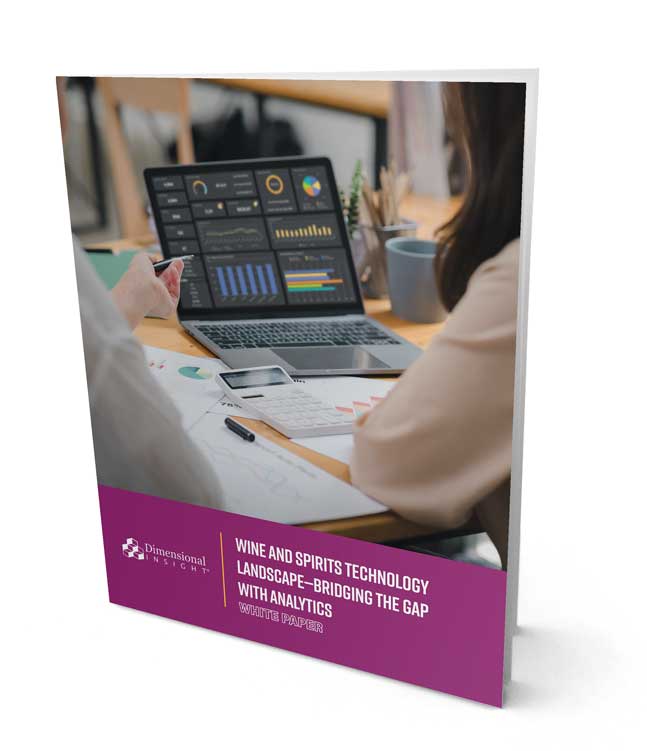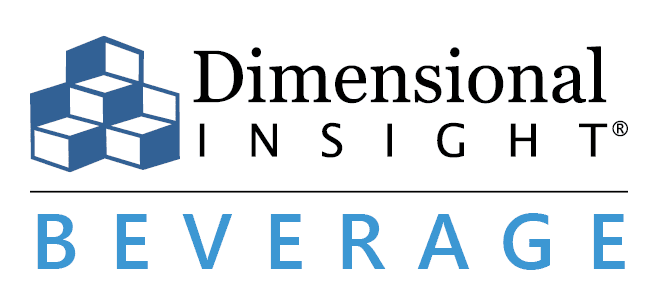
Wine and Spirits Technology Landscape—Bridging the Gap with Analytics

Wine and Spirits Technology Landscape—Bridging the Gap with Analytics
Even though wine and spirits have been celebrated for centuries, the industry is undergoing a major technological revolution. Businesses everywhere are adopting new tools and strategies in an attempt to keep up with the digital age and accommodate an evolving (and growing) consumer base. Likewise, vendors have begun to flood the market with new industry-specific software in an attempt to capitalize on the increased spending.
However, despite the wide selection of tools available, many businesses still struggle with navigating their wine and spirits tech stack and deploying solutions that align with their specific needs and overarching goals.
In today’s digital age, a streamlined and coordinated technology stack is essential for any supplier or distributor aiming to maximize its business potential. Central to this stack is an integrated analytics platform capable of providing robust data governance and detailed analysis.
Taking control—how analytics can optimize software investments
Poorly utilized software stacks mean businesses are:
A. Not maximizing available resources
B. Forgoing potential financial gains
C. Squandering funds on unnecessary expenditures
And probably,
D. All of the above
In essence, a company’s ROI is tethered to its efficiency, and the only surefire way to a streamlined tech environment is through data-driven insights.
Identifying software gaps and redundancies with data analytics
Many of the current platforms adopt a “universal solution” approach to wine and spirits technology, furnishing an array of tools to ease the initial burden of businesses setting up a tech landscape. At first glance, this seems advantageous.
But seasoned business leaders recognize that no single tool can resolve all challenges. With the wine and spirits industry flourishing, stakeholders are increasingly seeking options that offer flexibility, enabling customization in line with their specific objectives. Essentially, no one wants to be confined within a restricted tech environment.
This introduces a dilemma: how do businesses discern essential from redundant platforms? The answer lies in enterprise analytics.
A dedicated analytics solution consolidates data from disparate sources into one central location. Using a single interface, businesses can easily assess all their data streams and identify any weak links in their tech infrastructure. With numerous providers bundling various services, redundancies are common, leading to needless costs and diminished ROI.
On the other hand, a gap in the software stack suggests businesses are not fully leveraging their data or available resources. Every tier of a business’s operations presents opportunities for cost-savings and revenue gain, but these opportunities are only discernible with a competent analytics platform to highlight them.
The distributor dilemma: What’s in a code?
The “too many different tools” problem unfortunately compounds itself when we look at how distributor data is being reported to suppliers.
Suppliers urge distributors to consistently refresh their depletion data so that they can understand how their products are performing once they leave the supplier shelves. Unfortunately, the term “depletion” itself varies among distributors. For some, it encompasses breakage, samples, returns, and more, while for others, it doesn’t. Such discrepancies create obstacles for businesses trying to grasp their present operational status.
For suppliers aiming to get a holistic view of a product, irrespective of the distributor selling it, there’s a need to standardize product codes. This means taking all the varying distributor-assigned codes and converting them into a single, usable format—a process much easier said than done.
But, with the right analytics solution, this task suddenly becomes much more feasible. Businesses can automate their data ingestion as well as standardize all their incoming feeds. This enables supplier to review their distributors’ performance, regardless of how they report their data.
Beware of analytics from non-analytics vendors
Given the array of tech platforms now available, wine and spirits businesses must keep in mind that not all solutions are equal.
Today, many solutions offer embedded analytics as an added service. However, these inclusions often have restricted capabilities and lack a holistic perspective. Typically, these analytics functions are designed around their respective solution’s specific infrastructure. So, while they may cater to immediate and localized reporting requirements, they often fall short in broader contexts. For example, inventory management solutions may be sufficient for tracking depletions, but they lack the birds-eye-view necessary for evaluating overarching sales strategies.
These limitations often lead to manual input and data merging, consuming valuable time and resources. Furthermore, the absence of a centralized platform to synchronize all business data also raises reliability concerns.
Given the diverse reporting requirements in the wine and spirits realm, businesses need a platform that caters to the entire organizational structure. Niche analytics often lack the necessary breadth and support to serve enterprise-scale needs. For full tech stack optimization, businesses need an analytics solution adept at data integration across diverse roles and functions.
Data streams worth tracking
With the wine and spirits sector’s recent advancements, businesses have various software tools available, including:
Workflow integration
Inventory management
Sales programming
Financial management
Warehousing
Digital marketing
Compliance
Surveying
That’s a lot of tools, a lot of spending, and a lot of data. Given how many tools are now available, businesses often must spend substantial time and money on administrative tasks ensuring their data keeps flowing. Moreover, many of these systems have incompatible data formats, complicating inter-departmental data sharing.
Leveraging analytics to unify data channels
Faced with disparate data sources from varied tech infrastructures, how can businesses synchronize their data to bolster enterprise-wide operations?
One primary advantage of enterprise analytics platforms is their integration capabilities, enabling businesses to merge data from different systems into a cohesive view. This ensures consistent, real-time information access across departments, irrespective of individual tool usage.
Furthermore, businesses aren’t pigeonholed into a specific tech ecosystem. With a strategic analytics core, they can cherry-pick tools that suit their unique requirements. For instance, sales teams can utilize data from their inventory management as well as their marketing to evaluate what sales strategies they should be using to push the right products.
Without a system to harmonize and optimize their tools, businesses simply can’t fully harness their ROI potential.
Choosing the right analytics solution
When you’re ready to bring together your tech ecosystem and implement an enterprise analytics platform, there are many options to choose from. However, not all platforms are equal in the tools and resources they provide. Determining which platform is best for your organization comes down to what your long-term goals are and how you intend to reach them.
Dimensional Insight is one of the most trusted names in wine and spirits analytics. With built-in integration, KPIs, analytics, and visualization capabilities, we can not only help address your organization’s data needs from start to finish, but also do it better than other companies can.
Our technology is powerful. We have optimized our technology to provide unparalleled speed, integration, flexibility, and governance. Diver Platform provides an integrated set of analytical services that work together seamlessly to help you assemble and analyze the most relevant information. Other approaches that rely on multiple technologies lack the flexibility to meet the nuanced challenges of the wine and spirits industry. With Dimensional Insight, you gain real-time speed, seamless integration of data sources, the flexibility to view data the way you want to see it, and the governance that provides a single source of truth for your organization.
We are relentless. Our #1 priority has always been our customers and what they need to succeed. We work with our customers to understand their strategic goals, and then work collaboratively with them to meet those goals. Whereas other companies will implement the technology and move on to other projects, we stick with our customers until they succeed, and then work with them again to realize success in future projects as well.
We know wine and spirits. Our staff have spent decades solving customers’ most daunting analytical problems and fine-tuning Diver Platform® to deal with the unique challenges of wine and spirits data and information management.
There’s a reason we’re named year-after-year as an industry leader in both customer experience and vendor credibility in analyst reports. It’s because we get the results our customers are looking for.
If you’re curious what our platform could mean for your organization, email us at [email protected]
Download white paper:
Wine and Spirits Technology Landscape—Bridging the Gap with Analytics

